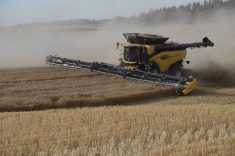Canada’s farmers will suffer if the country’s productivity crisis continues or even worsens.
That was the sobering message from Farm Credit Canada’s J.P. Gervais at the Canadian Pulse and Special Crops Convention. Canada’s productivity slump threatens to undermine what should be a golden future for Canadian farmers, especially pulse growers.
“I’m super-enthusiastic about the long-term outlook,” said Gervais in his macro markets presentation at the start of the convention.
Read Also

VIDEO: Ag in Motion documentary launches second season
The second season of the the Western Producer’s documentary series about Ag in Motion launched Oct. 8.
Canada’s agriculture industry is ideally situated and pulse crops offer the single greatest greenhouse gas emissions reduction tool that farmers have in hand, so Canada’s farmers should be able to gain and grow.
However, Canada is lagging further behind the United States in productivity growth. From 2017 to 2022, Canada’s productivity grew only 3.2 per cent, compared to 9.1 per cent in the U.S.
With only the 2012 to 2017 period as an exception, Canada’s productivity growth weakness goes all the way back to the late 1990s, making its economy progressively weaker compared to its main trading partner, competitor and rival for agricultural investment.
Specific agricultural productivity growth is in a long-term slide, the reversal of a boom that took off in the 1970s and topped out by 2000.
The 1980s alone saw a 23.4 per cent gain in Canadian agricultural productivity. The 1990s were almost as impressive, at 21.9 per cent. But the 2000s and 2010s saw steadily lower gains, with the 2010s at only 13.7 per cent productivity gains. That might not sound terrible, but if the trend continues, Gervais thinks ag may see less than one per cent growth per year in this decade.
The good news, if you can call it that, is that U.S. agriculture is suffering the same problem, and has seen its productivity gains fall even more than that of Canadian ag. That doesn’t put Canadian farmers at a competitive disadvantage, but it also means Canadian farmers can’t piggyback on U.S. growers for easy gains.
Canada’s export-oriented and free market farmers are part of a world market and deeply integrated with the North American economy. In some ways farmers are insulated from larger economic problems plaguing Canada.
To a degree this is true of productivity, which will see Canadian farmers employ machinery, management techniques and innovations that arise south of the border or anywhere in the world. Canadian farmers aren’t trapped within a closed market.
They are, however, reliant upon the rest of the economy, from labour to services to new products created specifically for Canadian farming conditions. Gervais noted Canada’s below-average research and development investment by the private sector compared to most other advanced nations. That’s not a recipe for creating innovations that will give farmers ever greater productivity.
Gervais would like to see Canadian ag get back to the two percent per year productivity gains that held in the 1990s and 2000s. That would mean an extra $3 billion in farmers’ pockets every year. That would be a big deal at the farm gate.
Is it the regulatory regime that’s strangling growth? Laws, rules and other complications can discourage people from investing their money. That possibility needs to be unravelled.
You can bet that will be discussed at length soon in Calgary. The University of Calgary’s School of Public Policy is holding what’s it’s calling Canada’s Productivity Summit, which will focus on many of the concerns raised to pulse and special crops growers. It’s occurring Oct. 16 and 17 and would be a good place for aggies to get ideas to share with fellow farmers.
Productivity isn’t a sexy topic that gets people chatting. It sounds dull.
But it’s vital to every farmer’s well-being. In Gervais’s words, it is “the most critical topic for the long-term outlook for the industry.”
That’s something to take seriously.


















